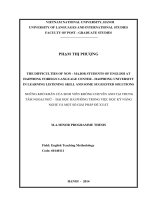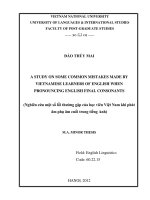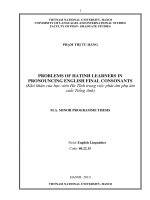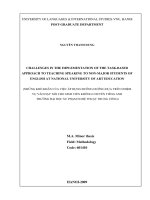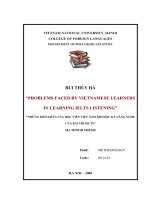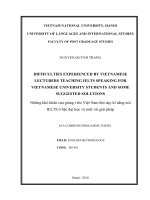Problems faced by Vietnamese learners in learning IELTS listening = Những khó khăn của học viên Việt Nam khi học kỹ năng nghe của bài thi IELTS
Bạn đang xem bản rút gọn của tài liệu. Xem và tải ngay bản đầy đủ của tài liệu tại đây (2.28 MB, 48 trang )
VIETNAM NATIONAL UNIVERSITY, HANOI
COLLEGE OF FOREIGN LANGUAGES
DEPARTMENT OF POST-GRADUATE STUDY
BÙI THÚY HÀ
“PROBLEMS FACED BY VIETNAMESE LEARNERS
IN LEARNING IELTS LISTENING”
“NHỮNG KHÓ KHĂN CỦA HỌC VIÊN VIỆT NAM KHI HỌC KỸ NĂNG NGHE
CỦA BÀI THI IELTS”
MA MINOR THESIS
Field: METHODOLOGY
Code: 60.14.10
HA NOI – 2009
VIETNAM NATIONAL UNIVERSITY, HANOI
COLLEGE OF FOREIGN LANGUAGES
DEPARTMENT OF POST-GRADUATE STUDY
BÙI THÚY HÀ
“PROBLEMS FACED BY VIETNAMESE LEARNERS
IN LEARNING IELTS LISTENING”
“NHỮNG KHÓ KHĂN CỦA HỌC VIÊN VIỆT NAM KHI HỌC KỸ NĂNG NGHE
CỦA BÀI THI IELTS”
MA MINOR THESIS
Field: METHODOLOGY
Code: 60.14.10
Supervisor: DR. DƯƠNG THỊ NỤ
HA NOI – 2009
v
TABLE OF CONTENTS
Declaration i
Acknowledgements ii
Abstract iii
List of tables and charts iv
TABLE OF CONTENTS v
CHAPTER 1: INTRODUCTION 1
1.1. Rationale 1
1.2. Aims of the study 1
1.3. Significance of the study 2
1.4. Scope of the study 2
1.5. Method of the study 2
1.6. Design of the study 2
CHAPTER 2: LITERATURE REVIEW 4
2.1. Listening 4
2.1.1. What is listening? 4
2.1.2. What is listening comprehension? 4
2.1.3.The importance of listening 5
2.1.3.1. Listening as the final goal of learning a language 6
2.1.3.2. Listening as a means of acquiring a language 6
2.1.4. What make listening difficult? 7
2.1.4.1. The linguistic factors 7
2.1.4.2. The non-linguistic factors 8
2.1.5. Potential problems in learning to listen to English 9
2.1.5.1. Lack of control over the speed at which speakers speak 9
2.1.5.2. Not being able to get things repeated 9
2.1.5.3. The listener’s limited vocabulary 9
2.1.5.4. Failure to recognise the ‘signals’ 10
2.1.5.5. Problems of interpretation 10
2.1.5.6. Inability to concentrate 10
2.1.5.7. Established learning habits 10
vi
2.2. Listening in IELTS tests 10
2.2.1. What is IELTS? 10
2.2.2. Listening in IELTS tests 11
2.2.3. Situation of teaching and learning IELTS listening of Vietnamese learners
in some foreign language centres in Hanoi 12
CHAPTER 3: THE STUDY 13
3.1. Data collection 13
3.1.1. Participants 13
3.1.2. Instrument 13
3.1.3. Data collection procedures 13
3.2. Data analysis and discussion 14
3.2.1. The questionnaire report - Part 1: General information about learners 14
3.2.2. The questionnaire report - Part 2: The learning and difficulties of IELTS
listening 16
3.2.3. . Data analysis of the class observation and discussion 26
3.3. Findings and conclusion 27
CHAPTER 4: RECOMMENDATIONS TO IMPROVE LISTENING SCORES IN
IELTS TESTS 30
4.1. To the IELTS learners 30
4.1.1. Learning to become efficient listeners 30
4.1.2. Practicing listening skill regularly and developing learning autonomy 31
4.2. To the IELTS teachers 31
4.2.1. Providing learners with necessary listening strategies 31
4.2.2. Developing listening materials and improving teaching techniques 32
4.2.3. Designing an intensive IELTS listening course for Vietnamese learners 32
CHAPTER 5: CONCLUSION 34
5.1. Conclusion 34
5.2. Limitation and suggestions for further study 35
REFERENCES I
APPENDIX II
iv
LIST OF TABLES AND CHARTS
1. TABLES
Table 1: Learners by age, gender and occupation
Table 2: Learners’ purposes of taking IELTS preparation course
Table 3: Learners’ feelings when listening
Table 4: Learners’ self- practice of listening skill
Table 5: How learners practiced listening skill themselves
Table 6: Factors caused difficulties for learners to learn listening
Table 7: Learners’ views on suggested topics
Table 8: Learners’ attitude towards IELTS listening activities
Table 9: Learners’ activities in listening lessons
Table 10: What learners do while learning to listen
Table 11: Learners’ expectation in learning to listen
Table 12: Teacher’s activities to help learners listen better
2. CHARTS
Pie chart 1: Learners’ experience of learning English in years
Pie chart 2: Learners’ opinion of learning listening skill
Pie chart 3: Learners’ opinion of the IELTS listening sub-test
1
CHAPTER 1: INTRODUCTION
1.1. Rationale
In recent years with the sound of economic growth and the global integration, there
have been a growing number of English learners wishing to study at a tertiary level or to
work in English speaking countries. However, one of the prerequisites for their entrance is
that they have to sit for either the International English Language Testing System (IELTS)
or the Test of English as Foreign Language (TOEFL). IELTS, which has now been
adopted by many English-medium universities all over the world, mainly in the United
Kingdom and Australia, especially in Australia, is administered by the British Council or
IDP Education Australia in Hanoi. The test consists of four sections designed to test
candidates‟ four skills: listening, reading, speaking and writing. As a matter of fact, those
who want to get high score to be admitted to the target universities all try to take part in
some preparation courses before taking the test and obviously, there are a great number of
English for Academic Purposes (EAP) Centres in Hanoi who run IELTS preparation
courses in order to meet these demands.
In second and foreign language learning, listening skill is always considered the
most essential as well as the most difficult skill for both teachers to teach effectively and
for learners to improve themselves. Therefore, listening in IELTS test is not an exception
because it comprises different task types with various topics and it requires not only
learners‟ proficiency in English but also their wide knowledge of the language, culture and
country as well.
Being both an IELTS learner and teacher, the author realises that listening skill is
really the most difficult skill to most English learners and the IELTS learners often
encounter a lot of difficulties with the IELTS listening subtest. This fact has encouraged
the author to investigate the real “Problems faced by Vietnamese learners in learning
IELTS listening” and to give some recommendations to help learners inprove their
listening skill as well as listening scores in IELTS test.
1.2. Aims of the study
The purpose of this study is to investigate real situation of learning IELTS
especially IELTS listening skill and the difficulties encountered by the IELTS learners in
2
IELTS preparation courses. Therefore, the study will aim to answer the following research
questions:
1. How is listening skill learnt by Vietnamese learners?
2. What problems do the IELTS learners face in learning IELTS listening?
3. What are IELTS learners‟ needs and expectation in learning listening skill?
1.3. Significance of the study
This study analyzes and finds out the real difficulties that Vietnamese learners face
while learning IELTS listening skill. By doing this study, the researcher would like to help
IELTS learners foresee the problems and overcome them in order to improve their
listening scores. The study is also done to help IELTS teachers adopt appropriate teaching
method to teaching this skill.
1.4. Scope of the study
The focus of the study is on the learning of IELTS listening skill of Vietnamese
learners who are taking part in IELTS Preparation Courses in some Foreign Language
Centres in Hanoi such as Language Link, Equest and private classes etc. The study was
conducted under the scope of a case-study research with a small number of participants
who were chosen at random and of different ages, occupations and locations. Therefore,
the investigation into the learning of other IELTS skills or the teaching of IELTS is
beyond the scope.
1.5. Method of the study
Both quantitative and qualitative approaches, including a survey questionnaire and
class observation, are employed to collect data for the study and the major method used is
the quantitative one. First of all, the survey questionnaire, which is conducted with those
learners who are taking part in the IELTS Preparation Courses, is to find out the
difficulties in learning IELTS listening as well as the current situation of learning this
skill. Then, the data for the study is also collected through class observation, informal
interviews and discussions with other IELTS teachers and learners.
1.6. Design of the study
Chapter 1: Introduction
This chapter is to present the rationale, the aims, the scope, the significance, the
methodology and the design of the study.
3
Chapter 2: Literature review
This chapter deals with the theoretical background of the study relating to
listening skill and IELTS listening.
Chapter 3: The study
This chapter presents data collection, data analysis, the findings and discussion as
well as the conclusion drawn from the study.
Chapter 4: Recommendations to improve listening scores in IELTS
tests
This chapter is to give some recommendations to both learners and teachers in
order to improve the learning and teaching of IELTS listening.
Chapter 5: Conclusion
This chapter presents summary of the major findings, the conclusions and
limitations of the study; implications as well as suggestions for further research.
4
CHAPTER 2: LITERATURE REVIEW
This chapter provides the theoretical background to the study composed of two
sections. The first section presents different views on the definition of listening and
listening comprehension; the importance of listening skill in foreign language learning; the
factors that make listening difficult and potential problems in learning listening skill. The
second section is to provide general information about IELTS, IELTS listening as well as
the current situation of teaching and learning IELTS of Vietnamese learners in Hanoi.
2.1. Listening
2.1.1. What is listening?
There are different definitions about listening, they come from different views of
the linguists. It is believed that listening is a significant and essential element of
communication and interaction in a native language and in second language as well.
Bentley and Bacon (1996), defines listening as „an active process during which the
listener constructs meaning from oral input’. From this definition, a learner can express
himself orally but he will never be able to communicate with an English speaker if he is
unable to understand what is said to him. Similarly, Grant also states that listening skill
includes everything from learning particular sounds to comprehending complicated
message. Without this skill, communication can break down. Steil and Watson (1983:22)
also view listening as a major communication activity.
On the website , listening is considered to be “the absorption
of the meanings of words and sentences by the brain. Listening leads to the understanding
of facts and ideas”.
Following is another view about listening :
Listening is an invisible mental process, making it difficult to describe.
Listeners must discriminate between sounds, understand vocabulary and grammar
structures, interpret stress and intention, retain and interpret this within the
immediate as well as the large socio-cultural context of the utterance.(Field,
1998:38).
The above definition presents a quite full overview of the nature of listening and
the difficulties that might face in communication or interaction.
2.1.2. What is listening comprehension?
5
Different definitions of listening comprehension focused on different aspects of
this skill. Rost (2002) defined listening comprehension as “a process of receiving what the
speaker actually says, constructing and representing meaning, negotiating meaning with
the speaker and responding, and creating meaning through involvement, imagination and
empathy”. To put it in another way, Wolvin and Coakley (1985) view listening as “the
process of receiving, attending to and assigning meaning to aural stimuli”. The definitions
suggest that listening is really a complex skill, the task of listening is more than the
perception of sound, it also requires comprehension of meaning.
Buck (2001:31) also points out that listening comprehension is “an active process
of constructing meaning and this is done by applying knowledge to the incoming sound”
in which “number of different types of knowledge are involved: both linguistic and non-
linguistic knowledge”. Therefore, when doing listening, listeners are expected to hear
attentively in order to process, comprehend, interpret, evaluate and respond to the
incoming data.
2.1.3. The importance of listening
Obviously, listening plays important and active role in communication and
interaction as it involves various kinds of the listeners‟ knowledge. The importance of
listening in second and foreign language learning is summarised in a recent publication by
Rost (1994:141) as follows:
- Listening is vital in the language classroom because it provides input for the
learners. Without understanding input at the right level, any learning simply
cannot begin.
- Spoken language including listening provides a means of interaction for the
learners. Because learners must interact to achieve understanding, access to
speakers of the language is essential. Moreover, learner’s failure to understand the
language they hear is an impetus, not an obstacle, to interaction and learning.
- Authentic spoken language presents a challenge for the learner to attempt to
understand language as it is actually used by native speakers
- Listening exercises provide teachers with a means for drawing learners’ attention
to new forms (vocabulary, grammar, interaction patterns)in the language.
6
- It is true that listening is of great essence, not only as a respective skill but also to
the development of the language proficiency. Listening skill is obviously a
necessary preliminary to the success of the language learning process.
Listening is said to be one of the essential elements of comprehension and
understanding. Therefore, in order to be successful in oral communication, people must
have the ability to interpret the message from the speakers by listening. “If our students do
not learn to listen effectively, they will be unable to take part in oral communication.
Merely to hear what a speaker says is insufficient for communication to occur. When
nobody listens to a speaker or when a listener fails to understand the message, we say that
communication has broken down” (Underwood, 1989: 4).
Furthermore, listening is an important way of acquiring the language, a good way
of picking up vocabulary and structures. Thus, teaching and learning listening in second
and foreign language is of great importance and the roles of listening in language learning
are presented as follows:
2.1.3.1. Listening as the final goal of learning a language
According to Donuogh, listening occupies the basic portion in the context of the
language arts and progess in reading, speaking and writing directly depends on listening
ability. In order to gain experience of listening to a wide variety of samples of spoken
language and improve this skill, learners can watch films, plays or listening to songs and
the radio. It helps learners know different varieties of language such as standard or
regional, formal or informal language and different text types like conversation, narrative,
descriptive,or lecture. Therefore, listening is regarded to be among the most important
educational goals of learning a language.
2.1.3.2. Listening as a means of acquiring a language
“Listening to spoken English is an important way of acquiring the language and
picking up structures and vocabularies” (Doff, 1995: 199). When listening, learners are
required to understand the message from the speakers so they can develop the ability to
perceive the language and also widen their vocabulary as well as gradually learn new
structures. The more they are exposed to the language, the more they do practice listening,
the faster and more easily they can acquire it. Listening in daily life can be watching
programs on T.V in English, listening to the radio or talking to native speakers.
7
2.1.4. What make listening difficult?
There are a number of studies conducted in order to find the appropriate method to
teach listening skill effectively and the difficulty learning this skill as well as the factors
that make this skill difficult to learn. Of the four skills: speaking, listening, reading and
writing; listening is usually considered to be the most difficult for learning. Learners often
complain that the speakers speak too fast, pronounce the words differently with varoius
stress and intonation.
Brown and Yule (1983:74) point out from their study that:
there are four main groups of factors, which can cause difficulty in
listeningcomprehension. These are the speaker (that includes the number of
speakers, the speaker’s speech speed, and the speakers’ accents); the listener (this
consists of the role of the listener, the level of response required and the listener’s
interest in the subject); the content (vocabulary, grammar, information structure
and background knowledge) and the support (whether there are pictures,
diagrams, visual aids )
However, Anderson and Lynch (1988:202) group the factors into three main
categories: the type of language, the purposes in listening and the context in which the
listening takes place. They did a number of experiments and found out the following
factors that make listening difficult:
- The organization of information
- The familarity of the topic
- The explicitness and sufficiency of the information
- The type of referring expressions used
- Whether the text described “static” relationahip (for instance, geometric figures)
or dynamic relationship (a car accident)
In summary, the factors that make listening difficult are devided into linguistic
factors and non-linguistic factors which will be presented as follows:
2.1.4.1. The linguistic factors
2.1.4.1.1. The type of language input
8
The type of language mentioned here is the colloquial language and formal
language of which the former is said to be spontaneous and informal, it usually causes
trouble for the learners‟ listening process. In general, colloquial language in speeches
affects the pronunciation of the word, use of vocabulary, grammar and syntax and these
cause difficulty in comprehending the listening text. Most learners oftten find it very
difficult to deal with colloquial words especially when talking to a native speaker. In fact,
this type of language is widely used in everyday talk, television, interviews, gossip, family
talk etc., and formal language is the standardised language mainly used at school,
speeches in formal situations.
2.1.4.1.2. Pronunciation, rhythm and intonation
The way that a word is pronounced is also one of the most difficult factors to most
English learners to recognise and comprehend. For example, the stress in a word is a big
matter to any learners; the elision and assimilation are also the causes of difficulty. Elision
is the loss of sound in rapid speech and assimilation is the way speakers modify their
pronunciation.
Another reason why listening is not easy is that the listeners are not familiar to the
rhythm and intonation of the English language. It is the way the words are stressed and the
way speakers turn their voice up or down in an utterance in order to draw the listeners‟
attention to the information. Ur, (1984) agrees that the English system of intonation and
rhythm can interfere with the foreign listeners‟ understanding of spoken English.
2.1.4.2. The non-linguistic factors
2.1.4.2.1. Listener‟s ability to concentrate
Concentration is really essential in doing anything and it is of great importance in
listening in particular. It is easier for the listeners to concentrate if the topics of listening
are interesting enough and related to common issues of everyday life, for example, family
issues, social activities, personality etc. By contrast, it is hard to concentrate if the material
or the tape recorder is not good or sometimes the outside factors like the length of time,
room facility, noise etc. may make concentration difficult, too.
2.1.4.2.2. Listener‟s background knowledge
9
According to Anderson and Urquahart (1984:48), listeners with different
background will have different level of listening comprehension and without cultural
background knowledge , they will have many difficulties in listening comprehension.
Cultural background plays an important role in comprehending the listening text,
therefore, in order to improve listening comprehension skill, listeners should pay attention
to both linguistic factors and the system of foreign culture whose language they are
studying.
2.1.5. Potential problems in learning to listen to English
“Although the problems are many and various, they are not all experinced by all
students nor are they experienced to the same degree by students from different
backgrounds”, in her study, Underwood (1989: 16) presents some potential problems that
learners may encounter when learning to listen as follows:
2.1.5.1. Lack of control over the speed at which speakers speak
It is believed that the greatest difficulty with listening comprehension, as opposed
to reading comprehension, is that the listeners cannot control how fast a speaker speaks.
This means they cannot keep up with the information and while dealing with the meaning
of one part, they often miss the next part or ignore a whole chunk because they fail to sort
it out quickly enough.
2.1.5.2. Not being able to get things repeated
In learning situation or conversation, the listeniner is not always in a position to get
the speaker to repeat an utterance. For recorded materials, the number of times to play
them is often under the listeners‟ control but in many learning situations, it‟s not the
listeners to decide whether to replay the recording or not. For example, in a class situation,
it must be the teacher‟s decision or in a test or examination, it cannot be decided by the
learners.
2.1.5.3. The listener‟s limited vocabulary
When listening to a foreign language, it is hard for listeners to understand the
conversations or the listening texts which occur in different contexts. Therefore, the
listeners have to do their best to listen and sometimes they have to deduce the meaning
from the contexts of listening. However, in some circumstances, there are unknown words
10
like suddenly dropped barriers which cause the listeners to stop listening and try to work
out their meanings so they cannot concentrate on listening the next part and often miss it.
2.1.5.4. Failure to recognise the „signals‟
In speech, speakers often use many ways to indicate that they are moving from one
point to another or giving an example or introducing a new idea ect. These signals can be
verbal like “first, second , next, then, after that” or they can be gestures, speaker‟s
intonation. Therefore, learners need to learn all these signals and try to recognise them
when listening in order to become effective listeners.
2.1.5.5. Problems of interpretation
In unfamiliar contexts, listeners often have difficulty in interpreting the meanings
of words or structures they hear even though they are able to hear every word and that‟s
why they misunderstand the speaker‟s intention in some cases. Moreover, the
interpretation of such non-verbal signals as facial expression, nods, gestures or tone of
voice is a big challenge for those who are from other cultures.
2.1.5.6. Inability to concentrate
In listening, listeners‟ ability to concentrate is a major problem because a little
distraction in listening may seriously influence their comprehension. Meanwhile,
concentration may depend on different factors, for example, topics of the listening texts;
listeners‟ feelings; the classroom or the quality of recorded materials etc.
2.1.5.7. Established learning habits
Because of traditional teaching method that focuses learners on grammar structures
and vocabulary, accuracy rather than fluency; learners gradually feel worried and
discouraged when they fail to hear or understand a particular word or phrase while
listening. Therefore, in order to become effective listeners, they have to overcome these
feelings and establish new learning habit focusing on general ideas of the listening texts.
2.2. Listening in IELTS tests
2.2.1. What is IELTS?
IELTS which stands for International English Language Testing System is a set of
international standardised tests designed to access the English language proficiency. The
test is administered by the British Council or IDP Education Australia in Hanoi. There are
two modules in IELTS, General Training Module and Academic Module, and candidates
11
can choose either of them according to their purpose for taking the test. The academic
training module is for those who wishing to be enrolled in the degree courses of
universities and other tertiary institutions while the general training is mainly for non-
academic purposes such as immigration, work experience or secondary education in
English-speaking countries.
The test is divided into four sections: listening, reading, writing and speaking. At
present, the listening and speaking sections are the same for both general and academic
modules. The reading and writing sections for General Training Module are less
demanding than those for Academic one. A score is given from 0 to 9 for each of the four
sections and the Overall Band Score is an average of these four scores. Then the Overall
Band Score will be interpreted from Expert User to Non User or Did Not Attempt The
Test and this result will be sent to the target universities or institutions as a requirement for
entrance. IELTS has been adopted by many English-medium universities all over the
world, mainly in the United Kingdom and Australia, especially in Australia.
2.2.2. Listening in IELTS tests
Listening is the first part of the IELTS test. It takes about 40 minutes and consists
of four sub sections, each covering a different type of language and context. There are 10
questions in each section, candidates will be given time to read the questions before
listening and they will hear each section once only. One of the important characteristics of
the IELTS listening is that various task types such as multiple choice and short-answer
questions, sentence completion, note/summary/flow-chart/table completion, labeling a
diagram, classification and matching are used. This means that candidates have to use
different listening skills as well as strategies including listening for specific information,
listening for gist or listening for general information to deal with this part.
The first two sections of the listening comprehension test are related to social
needs: section 1 is usually a conversation between at least two speakers and section 2 is
often a passage with only one person speaking. The last two sections are concerned with
language use in educational or training contexts: the third section is usually a conversation
with up to four speakers and the last section is often a lecture or a talk of general academic
interest.
12
Today, material for IELTS are various and available from many publishers. The
books differ according to the learning targets, for comprehensive IELTS preparation or
just focused on certain skills. The listening section in these books usually comprises
practice tests of various task types with different topics providing learners with useful
vocabulary, expressions, information and the anwser keys. Learners can easily choose any
books for their self-study and books that give learners helful hints, techniques or learning
strategies are also available.
2.2.3. Situation of teaching and learning IELTS in some Foreign
Language Centres in Hanoi
Currently, there are no state-owned schools or colleges in Vietnam teaching IELTS
courses officially. Therefore, learners who want to study these courses have to take them
in some foreign language centres. In Hanoi, now there are a lot of Foreign Language
Centres that run IELTS preparation courses such as Language Link, Appollo, Equest,
ACET, etc. Learners all have to take a placement test and based on the result of the test,
they are divided into classes of 12 to 15 of level A (from 4.0 to 4.5) or B (from 5.0); those
who get under 4.0 cannot enrol in IELTS preparation class but some foundation classes.
The main textbook at each centre is not the same. Teachers are both native and
Vietnamese depending on each centre, however, in some centres, teachers are qualified but
never trained as IELTS teachers. During the course, there are often three or four practice
tests to examine learners‟ progress periodically. However, there are still no courses that
focus on certain skills like IELTS listening, speaking, reading and writing so far.
13
CHAPTER 3: THE STUDY
3.1. Data collection
3.1.1. Participants
The participants of this study were fifty learners chosen at random from IELTS
preparation classes at Language Link, Equest and from my private class at home. They
were at the age between 15 to 35 and their occupation is of different fields, 68% of them
were students and the ratio of male and female was 28/50 (the number of male learners
counted for 56% of the total population). Their English background is not similar, the
number of years they spent learning English ranged from two years to over ten years at
school or at some Foreign Language Centres where grammar and vocabulary were
focused. Just 24% of the learners (12 learners) had taken 2 IELTS preparation courses
while the rest of them had never attended any courses before.
3.1.2. Instrument
Data for the study was mainly collected through the administration of a structured
questionnaire designed and assessed objectively to ensure the reliability and validity of the
study. The questionnaire consisted of two parts, the first one was about the personal
information of the learners including age, gender, occupation, learning experience, etc.
The second part was to find out the way learners learnt English listening skill, the
difficulties they had when learning it and their needs in learning this skill.
Apart from the questionnaire, the study also used data collected from class
observation, the writer‟s teaching experience and discussions with other IELTS teachers as
well as learners.
3.1.3. Data collection procedures
First of all, the questionnaire was completed by the 50 learners from four different
classes. The learners were asked to fill in the questionnaire objectively and seriously
within fifteen minutes. Before administering the questionnaire, the researcher had time to
explain the purpose, relevance and the importance of the study as well as to clarify any
questions that learners had. However, it took quite a lot of time to collect the data because
the participants were not at the same place and class as well.
14
Then, the data collected from the survey were read through for general information.
After that, they were analysed carefully. The results were then displayed in forms of tables
and charts.
Finally, the data for the study was also collected through class observation and
discussions with others IELTS teachers.
3.2. Data analysis and discussion
3.2.1. The questionnaire report - Part 1: General information about learners
Age
Gender
Total
Occupation
Male
Female
Student
Officer/
worker
Jobless
15 - 18
11
8
19 (38%)
34
11
5
19 - 23
7
9
16 (32%)
24 - 28
6
3
9 (18%)
29 - 35
4
2
6 (12%)
Total
28 (56 %)
22 (44%)
50 (100%)
68%
22%
10%
Table 1: Learners by age, gender and occupation
Looking at the table above, the total number of participants for the questionnaire
was 50, of which 22 were female and 28 were male. The majority of the total population
was students (68%) and aged from 15 to 23 at which learners had just finished high school
and began secondary school or university. 18% of the learners were at the age of from 24
to 28 and just 6 learners from 29 to 35. The second group of the learners who work in
different fields such as officers, workers, assistants, doctors, university teachers etc. makes
up 22% and just 10% of the selected subjects were looking for jobs and they took IELTS
test in order to get scholarship to study abroad.
All of the participants had learnt English for at least two years and at most ten
years at schools, universities or some Foreign Language Centres. Pie chart 1 below shows
the learners‟ experience of learning English. As indicated in the chart, about 44% of the
learners (22 learners) had spent from 8 to 10 years learning English and 30% (15 learners)
had been learning it for from 5 to 7 years. 14% of the total population had from 2 to 4
years experience of learning English and only 6 learners had learnt it for over 10 years.
15
Of all the learners, there were 12 learners (24%) who took the second IELTS
preparation course whereas the rest attended the first one therefore most of them had little
experience of learning IELTS.
Learners' experience of learning English in years
14%
30%
44%
12%
2-4 years
5-7 years
8-10 years
Over 10 years
Pie chart 1: Learners’ experience of learning English in years
The information presented in table 2 is about learners‟ purposes of learning
English.
Purposes
Number of learners
Percentage
study abroad
32
64%
work in a foreign company
16
32%
prepare for future job
28
56%
get promotion in your job
9
18%
communicate effectively in English
12
24%
have good command of English
4
8%
get a certificate
6
12%
Table 2: Learners’ purposes of taking IELTS preparation course
As can be seen from the table, most of the learners had clear aims in attending
IELTS preparation course. 64% of them learnt English in order to get scholarship to study
abroad whereas 32% aimed at finding a job in a foreign company or country. It is
surprising that nearly 60% of the learners learnt English to have good preparation for their
future job and 24% wanted to communicate to other people or foreigners fluently in
English. Some learners aimed at promotion in their job (18%), 12% wanted to get a
16
certificate and just 8% wished to improve their knowledge to become proficient English
users. In general, all of the learners had their own purposes of learning before taking part
in the course. Therefore, they had good attitude towards learning especially good
motivation in learning.
3.2.2. The questionnaire report - Part 2: The learning and difficulties of listening
skill
3.2.2.1. Learners‟ attitude toward the learning of listening
Question 1,2 and 3 aims at asking learners about their opinions of learning
listening skill, the answers are presented in the charts below:
48%
44%
8%
very important
important
a little
important
74%
20%
6%
difficult
very difficult
a little difficult
Pie chart 2: Learners’ opinion of learning listening skill
The first chart indicates that the majority of the learners were aware of the
importance of listening skill in their English learning. It is worth mentioning that over
90% of the learners considered listening an important and very important skill. None of
them found it not important or boring. However, in the second chart, nearly 95% of the
participants claimed that listening skill is difficult, of which 20% graded it very difficult. It
can be said that to these learners, improving listening skill is really a challenging task.
Therefore, almost all the learners were willing to develop this skill not only for its
importance but also for their own purposes of learning. The following table gives the
information about how learners felt when listening.
Options
Number of learners
Percentage
tense
27
54%
nervous
17
34%
17
anxious
14
28%
confused
24
48%
uncomfortable
15
30%
demotivated
11
22%
misunderstand spoken message
22
44%
unable to concentrate
29
58%
Table 3: Learners’ feelings when listening
It can be seen from the table the reasons why learners found listening skill difficult.
Many of them claimed that they were unable to concentrate on listening (58%) and a
similar number of them said they were tense when listening (54%). Moreover, nearly 50%
of the learners felt confused and often misunderstood the message. Besides, 34%, 30% and
28% were nervous, uncomfortable and anxious respectively. Because of the common
feelings listed above, some learners found demotivated in learning listening skill and this
makes it more difficult for them to improve the skill.
3.2.2.2. Learners‟ learning habit
The table below shows the learners‟ learning frequency and the time they spent
practicing listening (question 5 and 6)
Learning frequency
No. of learners/ %
Time spent
No. of learners/ %
everyday
18/ 36%
15 minutes
16/ 32%
2-3 times/ week
22/44%
30 minutes
23/ 46%
once a week
10/ 20%
60 minutes
7/ 14%
3 times a month
0
90 minutes
4/ 8%
Table 4: Learners’ self- practice of listening skill
As can be seen from the table, most learners spent time practicing listening at
home regularly. 44% of the learners practiced listening 2-3 times a week and a similar
number of them spent 30 minutes listening to English each time (46%). 36% of the
learners listened to English everyday and just 20% did it once a week. 32% spent 15
minutes, 14% listened 60 minutes each time and only 8% of the learners spent more than
an hour listening each time. In general, it can be said that most learners had good
motivation of learning and positive attitude towards practicing listening skill; almost all of
them said they wanted to develop this skill.
18
Question 7 was designed to find out how learners practiced their listening skill at
home and table 5 below shows the information collected. A noticeable finding from the
table is that the majority of the selected subjects chose to improve their listening skill by
listening to the news or English programs on the radio, T.V, and the Internet (58% and
72%). It is understandable because apart from radio, T.V and the Internet today are the
most popular means of telecommunication all over the world with a lot of English
programs available. 52% of the learners spent time chatting to friends or colleagues or
sometimes chatting online using English. 42% chose to watch films in English on cable
T.V and only 34% tried to talk to native speakers or foreigners as some of them said that
they felt shy and embarrassed when talking to English speakers.
Options
Number of learners
Percentage
Listen to the radio in English
29
58%
Listen to the news on T.V or the Internet
36
72%
Watch films in English
21
42%
Talk to native speakers or foreigners
17
34%
Chat to friends or colleagues ( or on line)
26
52%
Table 5: How learners practiced listening skill themselves
3.2.2.3. Learners‟ opinion of IELTS listening sub-test
Looking at the information presented in Chart 3 below about the learners‟ opinion
of the IELTS listening sub-test, we can realise that most of the learners found it difficult
(48%) and academic (42%); only 10% of the informants thought it was suitable to their
level. Furthermore, of the four sections of the listening sub-test, 48% of the learners found
section 3 the most difficult for them; 34% of them had problems with section 4 and just
18% chose section 2. None of the learners ranked section 1 the most difficult to learn
though some of them said it is difficult to some extent.
19
Learners' opinion of the IELTS listening sub-test
48%
42%
10%
difficult
academic
appropriate
Pie chart 3: Learners’ opinion of the IELTS listening sub-test
3.2.2.4. Factors caused difficulties in learning IELTS listening:
It is a clear finding that IELTS listening is not only difficult but also academic to
almost all learners selected in this current study. Question 10 was to find out the sources of
difficulties learners had to cope with and table 6 below presents the collected information.
Factors
Number of learners
Percentage
unfamiliar topics
42
84%
new vocabularies and structures
33
66%
speaker‟s fast speech
27
54%
different accents
26
52%
limited background knowledge
22
44%
different stress and intonation
22
44%
only listening once
19
38%
low quality tapes/ CDs
16
32%
simultaneous speaking
15
30%
cultural differences
11
22%
background noise
9
18%
poor listening equipment
5
10%
others
12
24%
Table 6: Factors caused difficulties for learners to learn listening
As mentioned previously, there are a number of problems that learners faced and
the sources of the problems are various, too. However, not all learners experience all
20
problems nor did they meet the same problem at the same time. Looking at the
information indicated in table 6, it is interesting to find out that all the learners had
different problems in learning listening skill. 84% of the learners had to cope with the
problem of unfamiliar topics which makes up the highest proportion of all the suggested
difficulties. Nearly 70% found more challenging with unknown words and grammar
structures, especially when listening to conversations. 56% and 54% said it is because of
speakers‟ fast speech and different accents respectively while 44% found it difficult
because of limited background knowledge and speakers‟ different stress and intonation.
Another factor that caused difficulty for 38% of the learners is that the tape is only played
once and never again any more, therefore, they could not catch and remember the
necessary information. A similar number of learners complained that low quality tapes or
CDs and speakers‟ simultaneous speaking caused problems for them to listen effectively.
Only 10% said it is because the listening equipment is below standard and about 20%
found cultural differences and background noise challenging to their listening ability. Last
but not least, 24% of the learners complained that the time they had for listening is very
limited, only 30 to 50 minutes for every three lessons (each about 2 hours; three lessons
per week). All they had to do is to practice themselves outside their class.
From the findings of question 10, table 6; the factor that caused the most difficult
for learners in learning listening is unfamiliar topics. In order to study further about this
difficulty, question 11 was designed to find out learners‟ views on the suggested topics
and the result is shown in table 7 below.
No.
Topics
No. of learners
Percentage
1
politics
13
26%
2
religion
9
18%
3
global issues
7
14%
4
crime and punishment
7
14%
5
science and technology
6
12%
6
social problems
4
8%
7
sports
2
4%
8
environment
2
4%
9
education
0
0%

